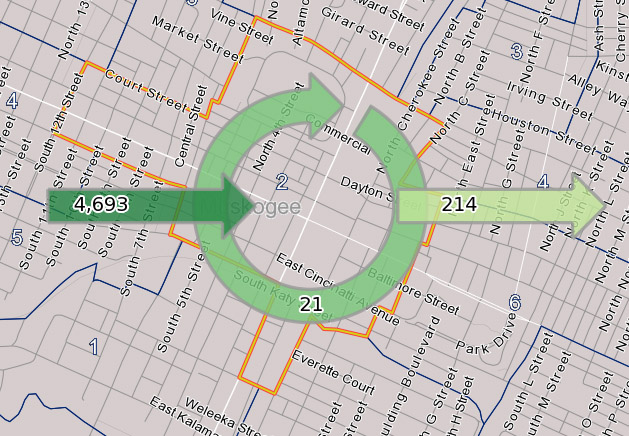
Migration of Workers into Downtown Muskogee
According to Longitudinal Economic Household Data collected by the U.S. Census Bureau, there are over 4,700 jobs in Downtown Muskogee, yet only a little over 400 people make the city center their home. A mere twenty-one people both live and work downtown, enjoying a walking commute and the many local attractions downtown like the Civic Center Arena, the Depot District, the Muskogee Farmers’ Market, the Roxy Theater, and shopping on Broadway, Main Street and at the Arrowhead Mall. The rest commute in and out every weekday with over fifty percent driving more than 10 miles and a full third coming from more than 25 miles, most likely Broken Arrow and Tulsa. They come all that way for good paying technical and professional jobs. Almost 40% of the jobs are in Public Administration working for the Veterans Administration, the County and Federal Courts, Muskogee County, and the City of Muskogee. Another 40% are in Health Care, Professional, Technical, and Educational Services and related fields. Over half the downtown workers have a college degree or some college education; they are a highly trained and well paid workforce.
Why don’t more of them choose to live near their workplaces? For one thing, there is a lack of housing units available, currently only 226 units in downtown proper. Despite a regional shopping mall, there is little in the way of basic goods and services like a grocery store or a pharmacy. There are no downtown parks or squares. Amenities like restaurants and recreation activities are also largely lacking, so there is little street life. Many buildings are underutilized with vacant storefronts and upper floors. Still more have been lost to demolition and replaced by parking lots, leaving a discontinuous streetscape.
In regards to our planning effort what are we to make of this situation? First, it means that downtown residents are not a large constituency and other constituencies may dominate the planning discussions, including business and property owners, government officials, and non-profit agencies. Considering the importance of downtown to the city and near downtown neighborhoods in particular, we may need to expand the reach of community engagement efforts to find out more about resident concerns. Second, the concentration of good jobs in Downtown Muskogee (more than one out of five jobs in the county) combined with so few housing units indicates there may be a latent demand for new housing. This is something that could be tested with a survey of downtown workers and a comparative market analysis. More research needs to be done to see if these exist already in some form. Lastly, it should be noted that this effort does not appear to be a repopulation effort. Census records indicate low population numbers in Downtown Muskogee going back to at least 1960. Housing in Downtown Muskogee is a largely new concept, at least for this generation.

Distribution of Employers in Greater Muskogee
